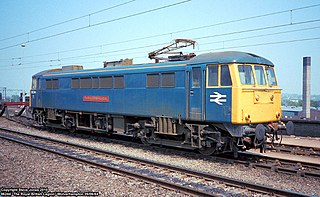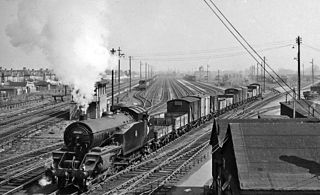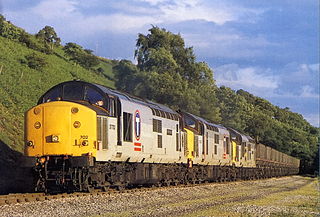
A switcher locomotive, shunter locomotive, or shifter locomotive is a locomotive used for maneuvering railway vehicles over short distances. Switchers do not usually move trains over long distances. Instead, they typically assemble trains in order for another locomotive to take over. Switchers often operate in a railyard or make short transfer runs. They may serve as the primary motive power on short branch lines or switching and terminal railroads.

Freightliner Group is a rail freight and logistics company headquartered in the United Kingdom. It is presently a majority owned subsidiary of the American holding company Genesee & Wyoming.

The British Rail Class 47 or Brush Type 4 is a class of diesel-electric locomotive that was developed in the 1960s by Brush Traction. A total of 512 Class 47s were built at Brush's Falcon Works in Loughborough and at British Railways' Crewe Works between 1962 and 1968, which made them the most numerous class of British mainline diesel locomotive.

The British Rail Class 86 is a class of electric locomotives built during the 1960s. Developed as a 'standard' electric locomotive from earlier prototype models, one hundred of these locomotives were built from 1965 to 1966 to haul trains on the then newly electrified West Coast Main Line (WCML) from London Euston to Birmingham, Crewe, Liverpool, Manchester and later Glasgow and Preston. Introduction of the class enabled the replacement of many steam locomotives, which were finally withdrawn by British Rail in 1968.

The British Railways Class 24 diesel locomotives, also known as the Sulzer Type 2, were built from 1958 to 1961. One hundred and fifty-one were built at Derby, Crewe and Darlington, the first twenty of them as part of the British Railways 1955 Modernisation Plan. This class was used as the basis for the development of the Class 25 locomotives.

Railfreight Distribution was a sub-sector of British Rail, created by the division in 1987 of British Rail's previous Railfreight sector. It was responsible for non-trainload freight operations, as well as Freightliner and Intermodal services. In its early years, the division was occasionally referred to as Speedlink Distribution. It was later responsible for freight operations through the Channel Tunnel.

Rail freight transport is the use of railways and trains to transport cargo as opposed to human passengers.

The British Rail Class 33, also known as the BRCW Type 3 or Crompton, is a class of Bo-Bo diesel-electric locomotives, ordered in 1957 and built for the Southern Region of British Railways between 1960 and 1962.

Harwich International railway station is a railway station on the Mayflower Line, a branch of the Great Eastern Main Line, the station serves Harwich International Port in Essex, England. It is 68 miles 72 chains (110.88 km) from London Liverpool Street, between Wrabness to the west and Dovercourt to the east. Its three-letter station code, HPQ, derives from its original name, Harwich Parkeston Quay.

The British Rail Class 46 is a class of diesel locomotive. They were built from 1961 to 1963 at British Railways' Derby Works and were initially numbered D138–D193. With the arrival of TOPS they were renumbered to Class 46. Along with the similar Class 44 and 45 locomotives, they became known as Peaks.

Tinsley was a railway marshalling yard near Tinsley in Sheffield, England, used to separate railway wagons from incoming trains and add them to new trains. It was sited immediately west of the M1 motorway, about one mile north of the Catcliffe junction. It was opened in 1965, as a part of a major plan to rationalise all aspects of the rail services in the Sheffield area; it closed in stages from 1985, with the run-down of rail freight in Britain. It was also the site of Tinsley Traction Maintenance Depot (TMD), which was closed in 1998; at its peak, 200 locomotives were allocated to this depot.

Longsight Diesel TMD is a railway diesel locomotive traction maintenance depot (TMD) situated in Longsight, Manchester, England. The depot code is LO. The depot is located 1+1⁄2 mi (2.4 km) south of Manchester Piccadilly on the eastern side of the line to Stockport. There are various roads in which individual train sets can be overhauled.

Mexborough engine shed was an engine shed in Swinton, in South Yorkshire, England. It was built by the Great Central Railway and opened in 1875. The shed was built slightly to the west of the current Mexborough station on land between the River Don and the River Don Navigation. It had 15 dead end roads, and could handle about 150 steam locomotives, mainly for use on freight trains. The London and North Eastern Railway operated the shed from 1923. In 1948, on the formation of British Railways Eastern Region, Mexborough bore the shed code 36B, then 41F from 1958. It closed in February 1964.

Tinsley Motive Power Depot, latterly Tinsley Traction Maintenance Depot (TMD), was a railway depot in Tinsley, South Yorkshire, near Sheffield. Access by road was from Brinsworth, near Rotherham. The depot was situated on the freight line between Treeton Junction and the A631 Shepcote Lane.

The British Rail Class 70 is a Co-Co mainline freight GE PowerHaul locomotive series manufactured by General Electric in Erie, Pennsylvania, United States. They are operated in the United Kingdom by Freightliner and Colas Rail. These locomotives replaced the Class 59 as having the highest tractive effort of any Co-Co Diesel locomotive in use in the United Kingdom when they were introduced.

Feltham marshalling yard, also known as Feltham hump yard, was a large railway marshalling yard designed for the concentration of freight traffic to and from South West London, and for transfer to other marshalling yards in London. It was built on the Waterloo–Reading line. It opened in 1918 and was closed by British Railways on 6 January 1969.

The railway network in Great Britain has been used to transport goods of various types and in varying volumes since the early 19th century. Network Rail, which owns and maintains the network, aims to increase the amount of goods carried by rail. In 2015–16 Britain's railways moved 17.8 billion net tonne kilometres, a 20% fall compared to 2014–15. Coal accounted for 13.1% of goods transport in Britain, down considerably from previous years. There are no goods transported by railway in Northern Ireland.

Leeds Midland Road depot is a locomotive and rolling stock maintenance facility located in Leeds, West Yorkshire, England. The site is located a few miles to the south-east of Leeds station on the line between Leeds and Castleford. Owned and operated by Freightliner, it is the heavy maintenance facility for its diesel and electric locomotives and wagon fleet.

Intermodal railfreight in Great Britain is a way of transporting containers between ports, inland ports and terminals in England, Scotland and Wales, by using rail to do so. Initially started by British Rail in the 1960s, the use of containers that could be swapped between different modes of transport goes back to the days of the London, Midland & Scottish Railway.

Basford Hall Yard is a railway marshalling yard near the town of Crewe, Cheshire, England. The yard, which is 0.93 miles (1.5 km) south of Crewe railway station, was opened in 1901 by the London and North Western Railway (LNWR). Initially used to marshal trains, the site now acts as a hub mainly for Freightliner intermodal trains, but also houses departmental sidings as used by Freightliner Heavy Haul, and other operators. For a period in the 1930s, Basford Hall was the busiest marshalling yard in Europe, handling between 28,000 and 47,000 wagons every week.






















